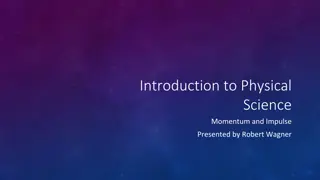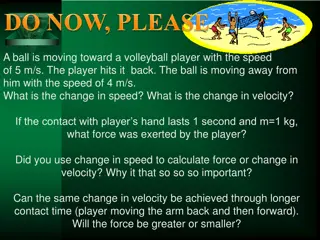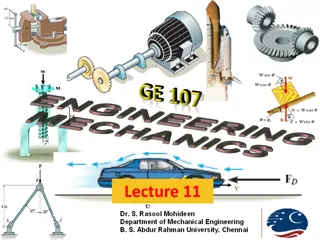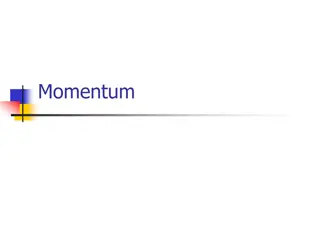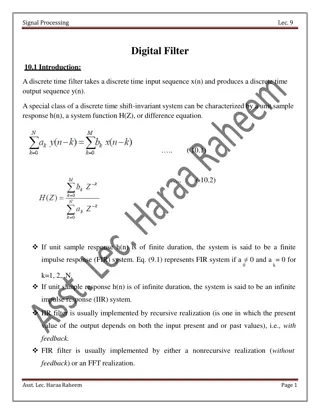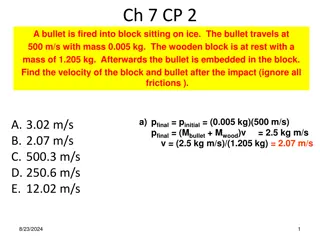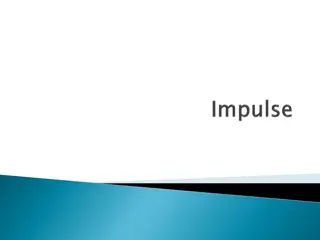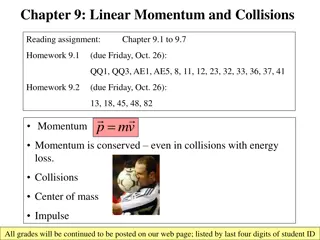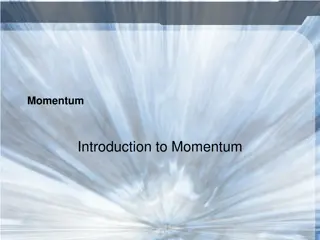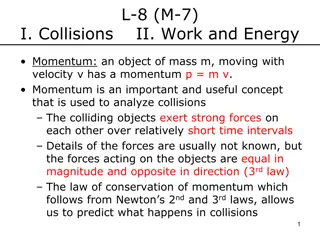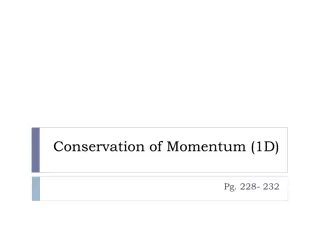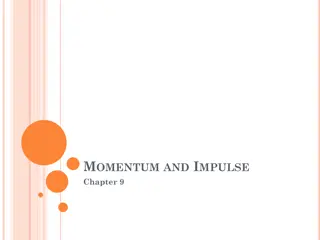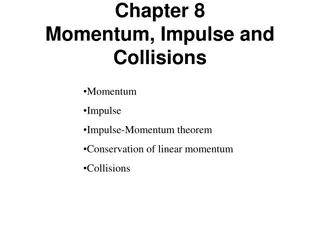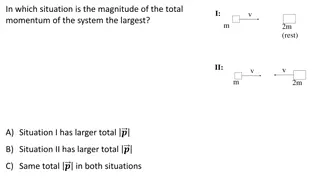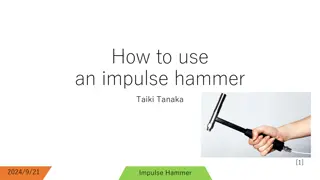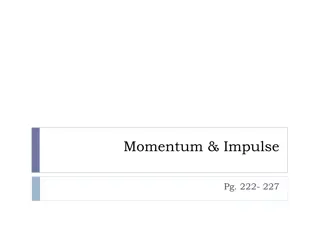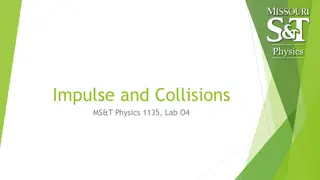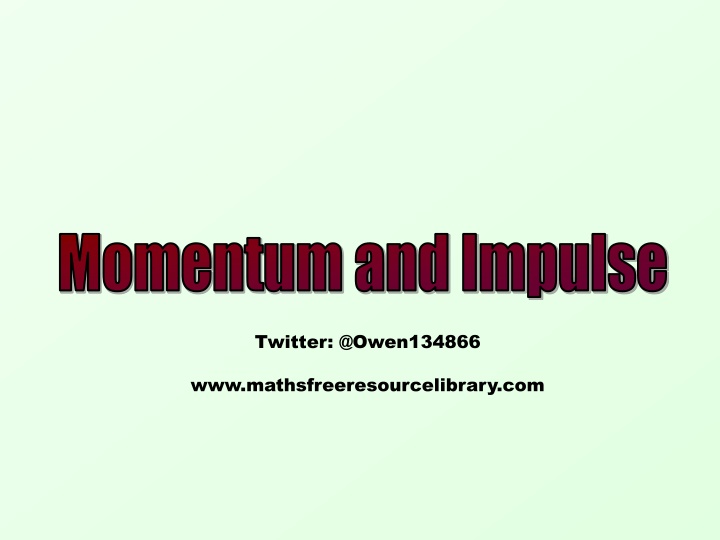
Understanding Momentum and Impulse in Physics
Learn about momentum, impulse, forces, and displacement in physics through practical examples and exercises. Understand how to calculate momentum, impulse, and resultant forces to solve physics problems effectively.
Download Presentation

Please find below an Image/Link to download the presentation.
The content on the website is provided AS IS for your information and personal use only. It may not be sold, licensed, or shared on other websites without obtaining consent from the author. If you encounter any issues during the download, it is possible that the publisher has removed the file from their server.
You are allowed to download the files provided on this website for personal or commercial use, subject to the condition that they are used lawfully. All files are the property of their respective owners.
The content on the website is provided AS IS for your information and personal use only. It may not be sold, licensed, or shared on other websites without obtaining consent from the author.
E N D
Presentation Transcript
Momentum and Impulse Twitter: @Owen134866 www.mathsfreeresourcelibrary.com
Prior Knowledge Check 3) A body of mass 2kg is acted on by a force ? N. The body starts from rest and moves in a straight line. After 5 seconds, the displacement of the body is 20m. Find the magnitude of ?. 1) The forces ?1= 3? 2? and ?2= 5? + 4? act on a particle. Find the magnitude and direction of the resultant force 2 17 ?, 14 above? 3.2? 2) A particle moves in a straight line with constant acceleration. a) Calculate ? when ? = 3, ? = 0.5 and ? = 5 b) Calculate ? when ? = 4.5, ? = 1.5 and ? = 2 5.5?? 1 6?
Momentum and Impulse You can calculate the momentum of a particle and the impulse of a force Find the magnitude of the momentum of: a) A cricket ball of mass 400g moving at 18ms-1 The momentum of a body of mass m which is moving with velocity v is given by mv ???????? = ?? Sub in units (remember to use kg) Calculate ???????? = 0.4 18 ???????? = 7.2?? If the mass is in kg and the velocity is in ms-1 then the momentum will be in kgms-1 b) A lorry of mass 5 tonnes moving at 12ms-1 kgms-1 can be written as (kgms-2)s ???????? = ?? Sub in units (remember to use kg) Calculate ???????? = 5000 12 As kgms-2 is Newtons ???????? = 60,000???? 1 kgms-1 can be written as Ns Either Ns or kgms-1 are acceptable units (make sure you read the question in case you re asked for one specifically!) These are both acceptable units for momentum Merriam-webster s definition 1A
???????? = ?? Momentum and Impulse You can calculate the momentum of a particle and the impulse of a force Remember that the acceleration of an object is given by: ? =? ? ? If a constant force F acts for time t we define the impulse of the force to be Ft ? = ?? Replace acceleration with the above ? ? ? ? = ? If force is measured in N and time in seconds, then the units of impulse are Ns Multiply by t ?? = ? ? ? Multiply the bracket out An example of impulse would be a cricket bat hitting a ball In this case, the time the force is exerted over is small, but if the force is big enough it will transfer noticeable impulse to the ball ?? = ?? ?? Force x time = Impulse! ? = ?? ?? So Impulse = Final momentum Initial momentum So Impulse = Change in momentum Merriam-webster s definition This is the Impulse-Momentum Principle! 1A
???????? = ?? ??????? = ?? ?? Momentum and Impulse ??????? = ?? You can calculate the momentum of a particle and the impulse of a force a) ??????? = ?? Sub in values ??????? = 6 4.5 A body of mass 2kg is initially at rest on a smooth horizontal plane. A horizontal force of magnitude 4.5N acts on the body for 6s. Find: Calculate ??????? = 27?? a) The magnitude of the impulse given to the body by the force 27Ns b) ??????? = ?? ?? Sub in impulse, the mass and the initial velocity 27 = (2 ?) (2 0) Calculate b) The final speed of the body 13.5ms-1 13.5 = ? 1A
???????? = ?? ??????? = ?? ?? Momentum and Impulse ??????? = ?? You can calculate the momentum of a particle and the impulse of a force 3.5ms-1 As always, draw a diagram! I 0.2kg A ball of mass 0.2kg hits a vertical wall at right angles with a speed of 3.5ms-1. The ball rebounds from the wall with speed 2.5ms-1. Find the magnitude of the impulse the ball exerts on the wall. 2.5ms-1 ??????? = ?? ?? The wall does not move and as such you cannot apply the Impulse-momentum principle to it. Sub in values, taking the final direction as positive ??????? = (0.2 2.5) (0.2 3.5) Careful with negatives! ??????? = 0.5 + 0.7 You can however apply the principle to the ball and use Newton s third law to deduce that the Impulse from the wall must be equal and opposite Calculate ??????? = 1.2?? 1A
???????? = ?? ??????? = ?? ?? Momentum and Impulse ??????? = ?? You can solve problems involving collisions using the principle of Conservation of Momentum Total momentum before impact = Total momentum after impact u1 u2 Before collision m1 m2 I I By Newton s third law, when two bodies collide they exert equal and opposite forces on each other. After collision v1 v2 The objects will also be in contact for the same length of time, so the impulse exerted by each will be equal but opposite in direction ?1?1+ ?2?2= ?1?1+ ?2?2 Total Total momentum of the two particles before impact momentum of the two particles after impact Therefore, these changes in momentum cancel each other out, and the overall momentum is unchanged When solving problems involving this principle: a) Draw a diagram and label velocities before and after impact with their relevant directions b) Draw impulses on where necessary c) Choose a positive direction and apply the rules you know This is the principle of Conservation of Momentum 1B
?1?1+ ?2?2= ?1?1+ ?2?2 Momentum and Impulse ???????? = ?? ??????? = ?? ?? ??????? = ?? You can solve problems involving collisions using the principle of Conservation of Momentum 3ms-1 0ms-1 Before collision P Q 2kg 3kg I I After collision A particle of mass 2kg is moving with speed 3ms-1 on a smooth horizontal plane. Particle Q of mass 3kg is at rest on the plane. Particle P collides with Q and after the collision Q moves away with a speed of 21/3ms-1. Find: v ms-1 21/3ms-1 We aren t sure which direction P goes after the collision just choose one for now If the answer is negative, the direction is the other way! ?1?1+ ?2?2= ?1?1+ ?2?2 Sub in the values from the diagram a) The speed and direction of the motion of P after the collision 0.5ms-1 in the opposite direction 13) (2 3) + (3 0) = (2 ?) + (3 2 Work out each side 6 = 2? + 7 b) The magnitude of the impulse received by P and by Q in the collision Calculate v 0.5 = ? So the direction of motion of P is reversed by the collision and it moves off at 0.5ms-1 1B
?1?1+ ?2?2= ?1?1+ ?2?2 Momentum and Impulse ???????? = ?? ??????? = ?? ?? ??????? = ?? You can solve problems involving collisions using the principle of Conservation of Momentum 3ms-1 0ms-1 Before collision P Q 2kg 3kg I I After collision A particle of mass 2kg is moving with speed 3ms-1 on a smooth horizontal plane. Particle Q of mass 3kg is at rest on the plane. Particle P collides with Q and after the collision Q moves away with a speed of 21/3ms-1. Find: 0.5ms-1 21/3ms-1 Impulse on P ? = ?? ?? Take the direction of impulse on P as the positive direction ? = (2 0.5) (2 3) Work out the brackets a) The speed and direction of the motion of P after the collision 0.5ms-1 in the opposite direction ? = 1 6 Calculate ? = 7?? You can see the impulse received by each is equal and opposite! b) The magnitude of the impulse received by P and by Q in the collision Impulse on Q ? = ?? ?? Take the direction of impulse on Q as the positive direction 13) (3 0) ? = (3 2 Calculate ? = 7?? 1B
?1?1+ ?2?2= ?1?1+ ?2?2 Momentum and Impulse ???????? = ?? ??????? = ?? ?? ??????? = ?? If you do not know a velocity s direction, set it the same as the direction of the impulse (this will keep it positive while you work it out!) You can solve problems involving collisions using the principle of Conservation of Momentum 3ms-1 2ms-1 Before collision P Q 2kg 4kg I I After collision Two particles, P and Q of mass 2kg and 4kg respectively are moving towards each other along the same straight line on a smooth horizontal plane. The particles collide. Before the collision, the speeds of P and Q are 3ms-1 and 2ms-1. Given that the magnitude of the impulse due to the collision is 7Ns, find: v1 ms-1 0.5ms-1 0.25ms-1 v2 ms-1 For particle P ??????? = ?? ?? Sub in values from the diagram, using impulse as the positive direction 7 = (2 ?1) (2 3) Work out brackets As this answer is positive, it means the direction we put on the diagram is correct! 7 = 2?1+ 6 Calculate 0.5 = ?1 a) The speed and direction of P after the collision For particle Q ??????? = ?? ?? Sub in values from the diagram, using impulse as the positive direction b) The speed and direction of Q after the collision 7 = (4 ?2) (4 2) Work out brackets As this answer is negative, it means the direction we put on the diagram is incorrect! 7 = 4?2+ 8 Calculate 0.25 = ?2 1B
?1?1+ ?2?2= ?1?1+ ?2?2 Momentum and Impulse ???????? = ?? ??????? = ?? ?? ??????? = ?? You can solve problems involving collisions using the principle of Conservation of Momentum 0ms-1 4ms-1 The particles do not collide in this case the impulse is transmitted through the string Before motion B A I I 2kg 8kg After motion Two particles, A and B, of masses 8kg and 2kg respectively, are connected by a light inextensible string. The particles are at rest on a smooth horizontal plane with the string slack. Particle A is projected directly away from B with speed 4ms-1. v ms-1 v ms-1 When the string is taut, the particles will move together and hence have the same final velocity ?1?1+ ?2?2= ?1?1+ ?2?2 Sub in values from the diagram, leaving v in both cases (2 0) + (8 4) = (2 ?) + (8 ?) a) Find the speed of the particles when the string goes taut v = 3.2ms-1 Work out brackets 32 = 10? Divide by 10 b) Find the magnitude of the impulse transmitted through the string when it goes taut 3.2 = ? 1B
?1?1+ ?2?2= ?1?1+ ?2?2 Momentum and Impulse ???????? = ?? ??????? = ?? ?? ??????? = ?? You can solve problems involving collisions using the principle of Conservation of Momentum 0ms-1 4ms-1 The particles do not collide in this case the impulse is transmitted through the string Before motion B A I I 2kg 8kg After motion Two particles, A and B, of masses 8kg and 2kg respectively, are connected by a light inextensible string. The particles are at rest on a smooth horizontal plane with the string slack. Particle P is projected directly away from Q with speed 4ms-1. 3.2ms-1 3.2ms-1 Calculating the impulse for B ??????? = ?? ?? Sub in values for particle B, taking the impulse from it as the positive direction ??????? = 2 3.2 (2 0) Calculate a) Find the speed of the particles when the string goes taut v = 3.2ms-1 ??????? = 6.4?? b) Find the magnitude of the impulse transmitted through the string when it goes taut I = 6.4Ns This is all we need to do. The impulse in the opposite direction will be the same! 1B
?1?1+ ?2?2= ?1?1+ ?2?2 Momentum and Impulse ???????? = ?? ??????? = ?? ?? ??????? = ?? You can apply the principles you have learnt when the variables are given as vectors (A2 level only) ??????? = ?? ?? Sub in values 3? 2? = 0.2? 0.2 10? 5? A particle of mass 0.2kg is moving with velocity 10? 5? ?? 1 when it receives an impulse 3? 2? ??. Find the new velocity of the particle. Expand the bracket 3? 2? = 0.2? 2? + ? Add 2i, subtract j 5? 3? = 0.2? Multiply by 5 25? 15? = ? 1C
?1?1+ ?2?2= ?1?1+ ?2?2 Momentum and Impulse ???????? = ?? ??????? = ?? ?? ??????? = ?? You can apply the principles you have learnt when the variables are given as vectors (A2 level only) ??????? = ?? ?? Sub in values ??????? = 0.17 15? 7? 0.17(10? + 5?) Expand Brackets An ice hockey puck of mass 0.17kg receives an impulse Q Ns. Immediately before the impulse the velocity of the puck is 10? + 5? ?? 1 and immediately afterwards its velocity is 15? 7? ?? 1. Find the magnitude of Q and the angle between Q and i. ??????? = 2.55? 1.19? 1.7? 0.85? Simplify ??????? = 0.85? 2.04? Sketch! 0.85? 0.852+ 2.042 ? = Calculate ? ? = 2.21 ?? 2.04? ? ? = ??? 12.04 0.85 Calculate ? = 67.4 1C
?1?1+ ?2?2= ?1?1+ ?2?2 Momentum and Impulse ???????? = ?? ??????? = ?? ?? ??????? = ?? You can apply the principles you have learnt when the variables are given as vectors (A2 level only) ?1?1+ ?2?2= ?1?1+ ?2?2 Sub in values 0.15(20? 10?) + 0.25(16? 8?) = 0.4? Expand and simplify Divide by 0.4 A particle of mass 0.15kg is moving with velocity 20? 10? ?? 1 when it collides with a particle of mass 0.25kg moving with velocity 16? 8? ?? 1. The two particles coalesce and form one particle of mass 0.4kg. Find the velocity of the combined particle. 7? 3.5? = 0.4? 17.5? 8.75? = ? 1C

